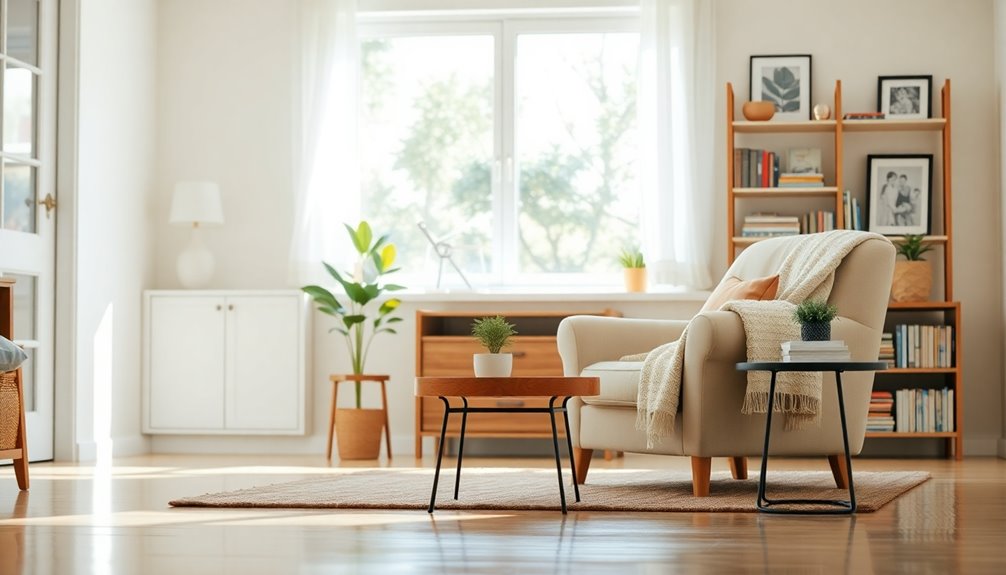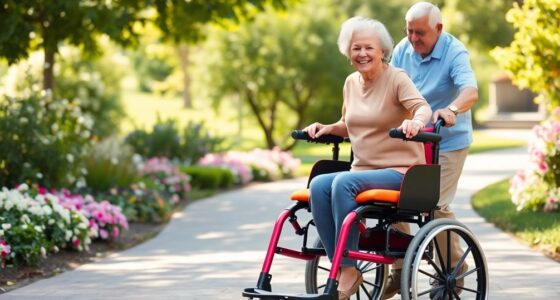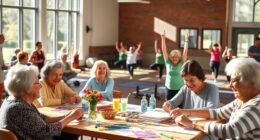To create a safer home for seniors, start with one room at a time. Make piles for keeping, throwing out, and donating items. Get rid of hazardous items like expired medications and broken glass. Consider a 90-day test for unused items. Eliminate duplicates, and organize everything in their designated places. Prioritize safety by clearing pathways and improving lighting. Finally, create a comfortable environment with familiar decor. Discover more tips to enhance safety at home as you continue to simplify.
Key Takeaways
- Start by decluttering one room at a time to avoid overwhelming seniors and maintain focus on safety.
- Create three piles: keep, throw out, and donate, ensuring only necessary and safe items are retained.
- Remove tripping hazards like old rugs and floor clutter to create a safer walking environment.
- Organize frequently used items in easily accessible locations to reduce the risk of falls and confusion.
- Regularly assess and improve lighting in living spaces to enhance visibility and prevent accidents.
Start With One Room
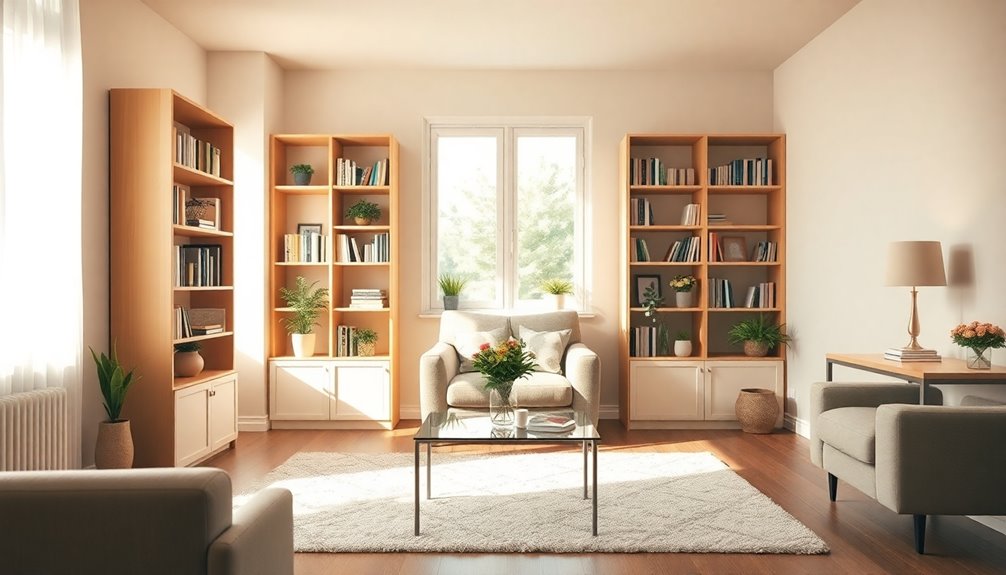
When you're ready to tackle decluttering, start with one room to keep the process manageable. Choose a space that usually collects clutter, like the living room or kitchen, for immediate results.
Setting small goals, like sorting through a single drawer or shelf, helps you stay motivated and focused. By concentrating on one room at a time, you'll feel accomplished as you see progress.
Aim to declutter one room each week; this gradual approach prevents overwhelm and creates a sustainable routine. Regularly reviewing items in that space will help you avoid future clutter and minimize tripping hazards, creating a safer environment.
With each small step, you'll transform your home into a more organized and pleasant place.
Make Piles: Keep, Throw Out, Donate
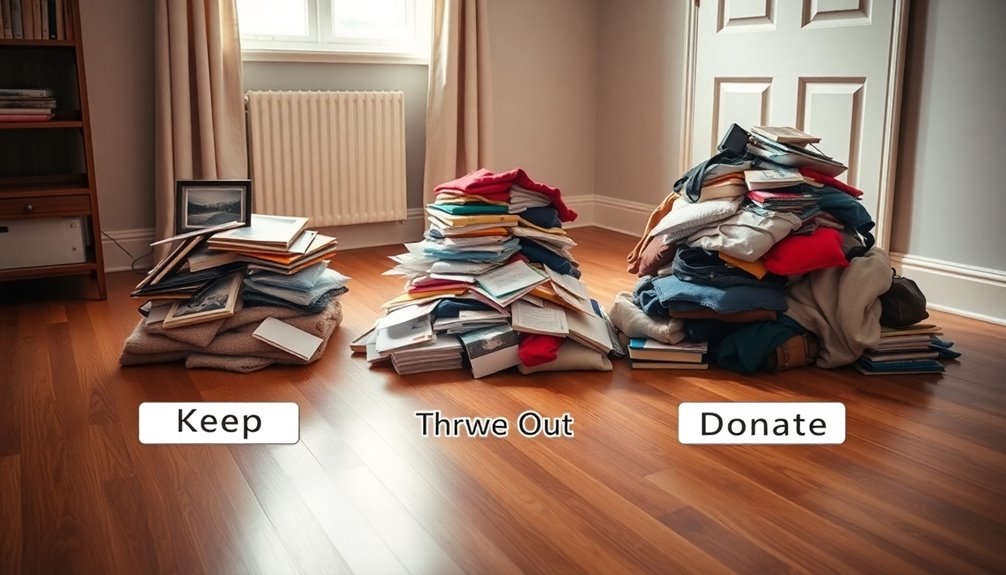
Decluttering can feel overwhelming, but making three distinct piles—keep, throw out, and donate—simplifies the process.
Start by evaluating each item and deciding if it's something you truly need or use. If it's not, you can either throw it out or donate it. Donating items gives them a new life, benefiting others and connecting you to your community.
Consider creating a "maybe" pile for items that hold sentimental value; this allows you to revisit those decisions later without pressure.
Regularly check your piles to verify everything is categorized correctly. Remember, the goal is to create a safer home, so throwing out anything broken or unnecessary enhances your living environment and helps you feel more organized. Additionally, adopting minimalist lifestyle principles can further simplify your living space and promote a more serene atmosphere.
Get Rid of Hazardous Items
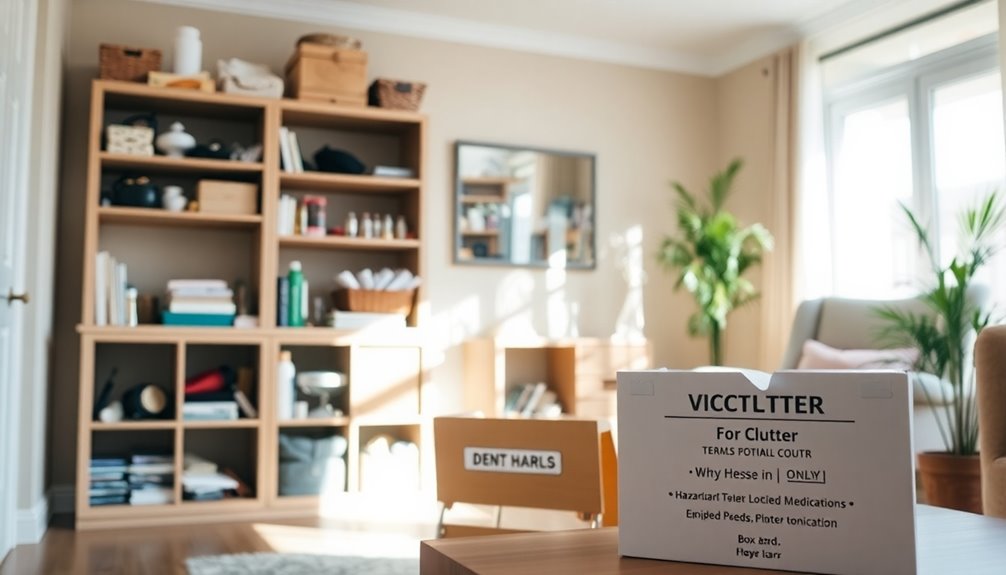
A safe home environment is essential for seniors, and getting rid of hazardous items is a key step in achieving that.
Fall prevention is vital since falls are the leading cause of injury-related deaths for adults aged 65 and older. Here are three important areas to focus on:
- Remove Old Rugs and Floor Clutter: Eliminate items that create tripping hazards.
- Discard Expired Medications and Food: Prevent accidental ingestion or contamination by clearing out old items.
- Eliminate Broken Glass and Unused Electronics: Clear pathways of broken items and clutter, reducing the risk of trips and falls.
Additionally, ensuring a smoke-free environment can further enhance newborn safety guidelines for all ages.
Regularly evaluating and removing these hazardous items promotes a safer home and helps maintain mobility and cognitive function.
Make a Pile of Unused Items and Do a 90-Day Test

Start by setting aside a box for items you haven't used in a while.
After 90 days, check if you really needed those items, which can help you decide whether to keep, donate, or toss them.
Set Aside Unused Items
When you realize that some items in your home haven't been touched in ages, it might be time to create a pile of those unused belongings. Start by setting aside a box for these items. Over the next 90 days, evaluate their necessity while keeping them accessible for retrieval.
Here are some decluttering tips for seniors to contemplate:
- Only keep items that serve a purpose or bring joy.
- After 90 days, check if you've used any items from the box.
- If not, think about discarding or donating them.
This method not only reduces clutter but also eases the emotional burden of decluttering. Additionally, a clean and organized space can significantly enhance mental well-being, promoting a sense of control and reducing stress.
Assess After 90 Days
After setting aside a box for items you haven't used in a while, the next step is to assess those belongings after 90 days.
During this period, keep the box accessible, allowing you to retrieve any items if necessary.
Once the 90 days are up, take a moment to evaluate the contents. If you haven't used any of the items, consider them for disposal or donation.
This process not only helps you declutter but also reassures you and your loved ones that you can always repurchase items if needed later.
Reassure Future Repurchase Options
To ease the process of decluttering, consider creating a pile of unused items and putting them in a box for a 90-day test. This strategy can help reassure you that you won't lose anything essential.
Here's how to make the most of this approach:
- Set aside a box for unused items, allowing easy access during the trial period.
- Evaluate each item after 90 days; if you haven't used it, it can be discarded or donated.
- Remember that if you need an item later, it can be repurchased.
This method alleviates anxiety, letting you assess your true needs without pressure. Embracing this mindset makes decluttering less intimidating, fostering a safer home for seniors.
Get Rid of Duplicates
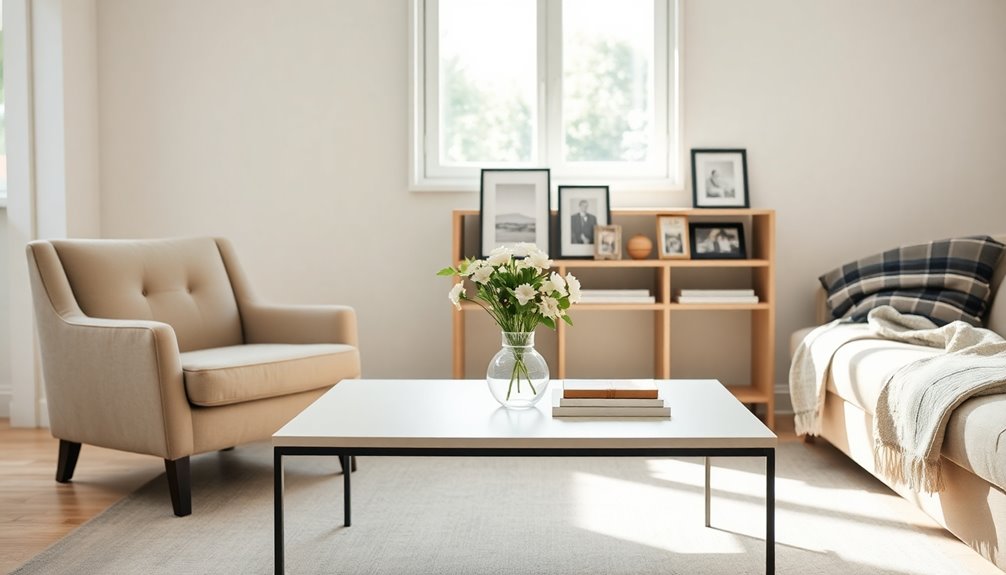
Duplicates can clutter your space and make it harder to find what you really need. To create a safer home, start by identifying and getting rid of duplicate items like kitchen gadgets, utensils, and towels.
Keeping only one of each essential item simplifies your living environment, making it easier to access what's necessary without distractions. This also reduces tripping hazards, which is vital for seniors.
Streamlining your belongings not only enhances the visual appeal of your home but also minimizes the time and effort needed for upkeep. By choosing to keep the preferred or better version of each item, you'll feel more satisfied with your possessions while promoting a manageable and safer living space. Additionally, implementing vertical storage solutions can further optimize your space and reduce clutter.
Organize Everything Where It Should Be
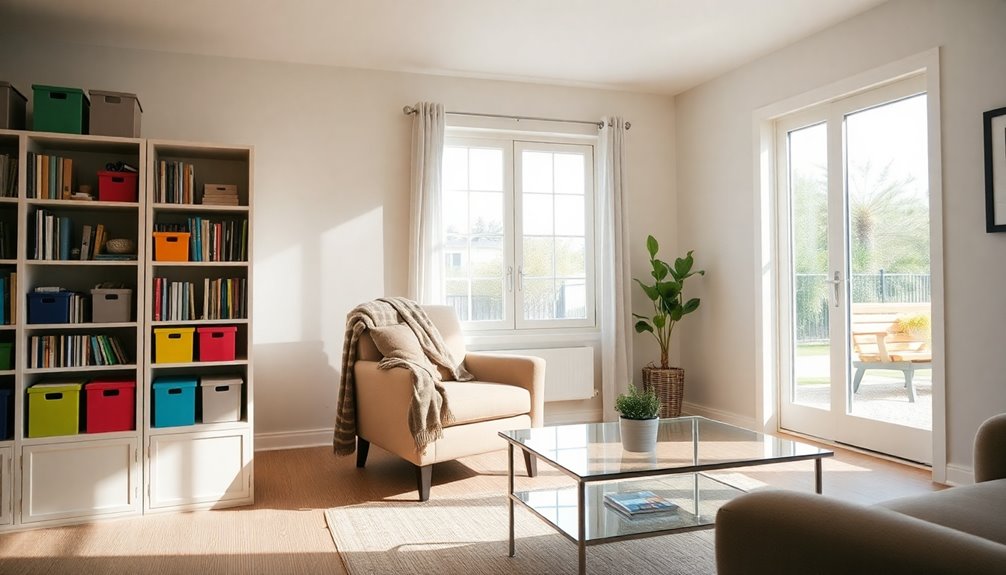
Organizing your home can make a world of difference in your daily life. By creating a structured environment, you can streamline your activities and minimize searching for necessities.
Here are three tips to help you organize everything:
- Assign specific places for every item to guarantee everything has a home, reducing clutter and confusion.
- Store frequently used items in easily accessible locations to prevent reaching or bending, which can lead to falls.
- Use labeled storage bins to categorize items, making it easy to identify and locate belongings.
Regularly assess your spaces to maintain tidiness and foster a habit of returning items to their designated spots.
This organized storage system will greatly make the process easier and promote a safer home for you.
Prioritize Safety
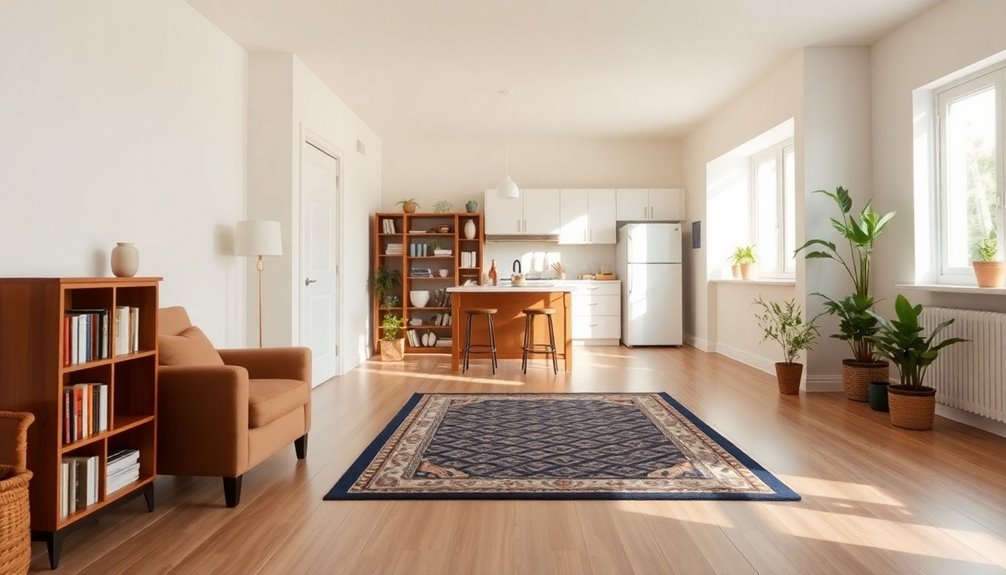
To keep your home safe, start by clearing pathways and hallways of any obstacles. Removing tripping hazards like rugs and loose cords can greatly reduce the risk of falls. Additionally, organizing frequently used items so they're easily accessible will help you avoid unnecessary stretching or bending. Consider incorporating low furniture to promote independence and reduce the risk of accidents in the home.
Clear Pathways and Hallways
As you navigate your home, keeping pathways and hallways clear is essential for your safety. Clutter can lead to tripping and falling, which poses serious risks, especially for seniors.
Here are some practical tips to guarantee clear pathways:
- Arrange furniture to allow at least 36 inches of walking space.
- Remove items from the floor, like shoes and decor, to maintain unobstructed paths.
- Use adequate lighting in hallways and pathways to enhance visibility.
Regularly assess frequently used areas and keep essential items accessible without creating obstacles. Additionally, consider installing best home security systems to enhance your safety further.
Remove Tripping Hazards
One of the most effective ways to enhance safety in your home is by removing tripping hazards. Start by clearing floors of old rugs, shoes, and other items that can obstruct movement. Verify hallways and staircases are well-lit and free of obstacles, as dark areas can increase fall risks. Regularly assess frequently used rooms, especially kitchens and bathrooms, where slips are more common.
| Action | Benefit |
|---|---|
| Remove clutter | Reduces tripping hazards |
| Improve lighting | Enhances visibility |
| Use storage solutions | Keeps items off the floor |
Organize Frequently Used Items
When organizing frequently used items, prioritizing safety can greatly enhance your daily routine.
To create a safer environment, keep in mind these tips:
- Store essentials within easy reach: Place kitchen utensils, medications, and personal care products at waist level to avoid bending or stretching.
- Designate specific areas: Keep keys, mail, and daily items in consistent locations to prevent confusion and reduce search time.
- Use clear storage bins: This allows for easy visibility and quick access, minimizing unnecessary movement that could lead to accidents.
Create a Comfortable Environment
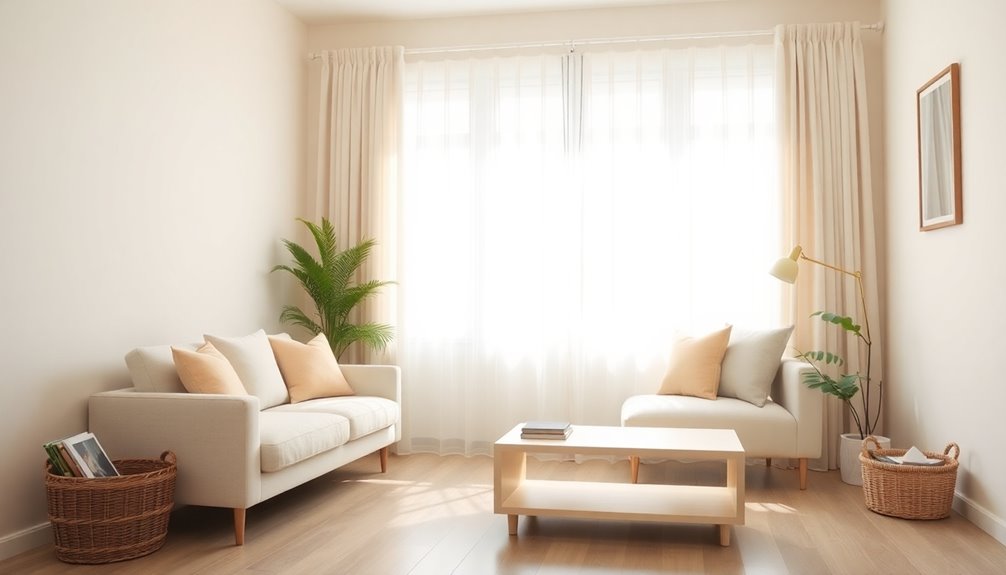
Creating a comfortable environment is essential for making the decluttering process easier for seniors. Start by ensuring the decluttering space is well-lit to reduce eye strain. Provide comfortable seating, so seniors can take necessary breaks and avoid physical strain. Incorporate familiar items and decorations to create a comforting atmosphere and ease anxiety. Additionally, keep the space free from extreme temperatures to enhance their experience. Regularly maintaining air purifiers can also contribute to better air quality, further promoting a soothing environment.
Here's a quick overview of creating a comfortable environment:
| Element | Importance | Tips |
|---|---|---|
| Comfortable Seating | Prevents physical strain | Use supportive chairs |
| Familiar Items | Eases anxiety | Add personal decorations |
| Well-Lit Space | Enhances visibility | Use bright, soft lighting |
| Ample Decluttering Space | Fosters focus | Clear clutter around the area |
| Temperature Control | Promotes engagement | Maintain a comfortable climate |
Frequently Asked Questions
What Is the 12-12-12 Rule for Decluttering?
The 12-12-12 rule for decluttering is a simple yet effective method.
You find 12 items to throw away, 12 items to donate, and 12 items to relocate. This approach makes decluttering manageable and less overwhelming.
By setting this specific goal, you can complete the task in about an hour. Regularly applying this rule helps you gradually reduce clutter, making your living space more organized and easier to navigate.
Plus, it fosters a sense of accomplishment.
What Is the Core 4 Method of Decluttering?
Have you ever felt overwhelmed by clutter and wondered if there's a better way to tackle it?
The Core 4 Method of decluttering can help you regain control. You'll sort your belongings into four categories: Keep, Donate, Discard, and Decide Later.
This structured approach makes decision-making easier and less stressful. By creating a "Decide Later" pile, you can take your time, ensuring you're only holding onto what truly matters to you.
What Is the 20 Rule of Decluttering?
The 20 Rule of decluttering suggests that for every new item you bring into your home, you should remove at least 20 items.
This rule encourages you to be intentional about your purchases, prompting you to think critically about what you truly need.
What Is the 5 Year Rule for Decluttering?
Think of your belongings like a garden; if something hasn't bloomed in five years, it's time to prune.
The 5 Year Rule for decluttering suggests that if you haven't used an item in that time frame, you probably don't need it anymore. This rule simplifies the decluttering process, helping you identify what's truly valuable and encouraging you to create space for the essentials.
Regularly reassessing your items can prevent future clutter and keep your space organized.
Conclusion
By following these decluttering tips, you can transform your home into a safer and more comfortable space for seniors. As you tackle each room, remember: a clutter-free environment not only reduces hazards but also promotes peace of mind. Isn't it worth the effort to create a space where loved ones can thrive? Start today, and watch how a little organization can lead to a happier, healthier home for everyone.
